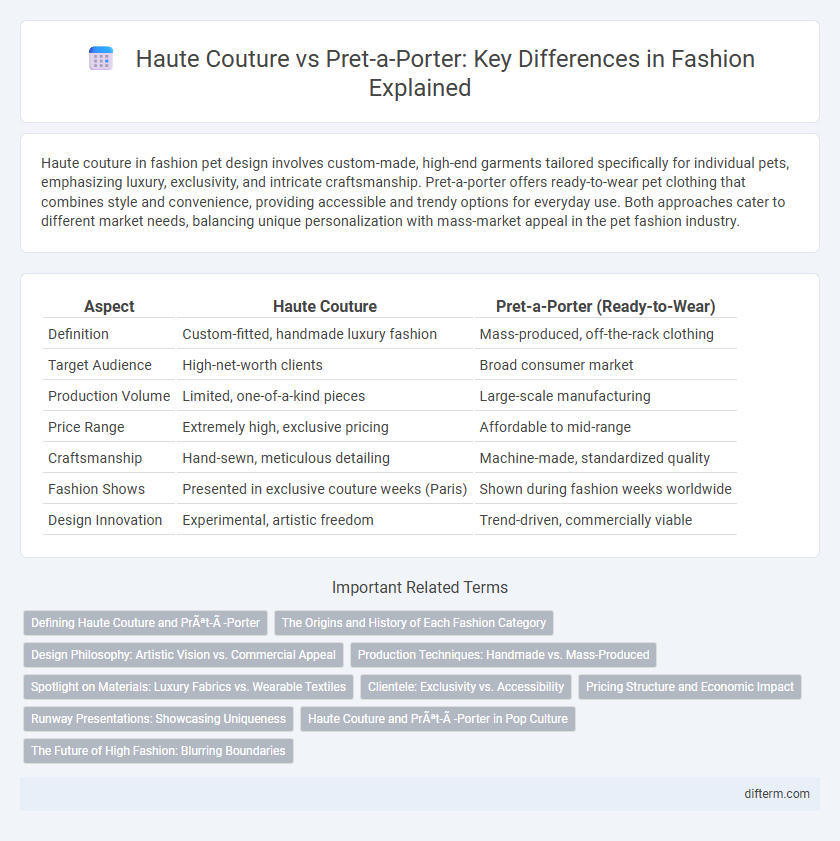Haute couture in fashion pet design involves custom-made, high-end garments tailored specifically for individual pets, emphasizing luxury, exclusivity, and intricate craftsmanship. Pret-a-porter offers ready-to-wear pet clothing that combines style and convenience, providing accessible and trendy options for everyday use. Both approaches cater to different market needs, balancing unique personalization with mass-market appeal in the pet fashion industry.
Table of Comparison
| Aspect | Haute Couture | Pret-a-Porter (Ready-to-Wear) |
|---|---|---|
| Definition | Custom-fitted, handmade luxury fashion | Mass-produced, off-the-rack clothing |
| Target Audience | High-net-worth clients | Broad consumer market |
| Production Volume | Limited, one-of-a-kind pieces | Large-scale manufacturing |
| Price Range | Extremely high, exclusive pricing | Affordable to mid-range |
| Craftsmanship | Hand-sewn, meticulous detailing | Machine-made, standardized quality |
| Fashion Shows | Presented in exclusive couture weeks (Paris) | Shown during fashion weeks worldwide |
| Design Innovation | Experimental, artistic freedom | Trend-driven, commercially viable |
Defining Haute Couture and Prêt-à-Porter
Haute couture represents exclusive, custom-fitted clothing crafted by hand from high-quality fabrics, emphasizing intricate detailing and unique design tailored for individual clients. Pret-a-porter, or ready-to-wear, consists of mass-produced collections designed for immediate purchase and broader market accessibility, offering stylish yet standardized garments. The distinction lies in haute couture's personalized artistry versus pret-a-porter's blend of fashion-forward design and commercial availability.
The Origins and History of Each Fashion Category
Haute couture originated in 19th-century Paris, pioneered by Charles Frederick Worth, who is credited as the father of high fashion, establishing exclusive, hand-crafted garments tailored to elite clientele. Pret-a-porter, emerging in the mid-20th century, focused on ready-to-wear clothing designed for a broader market, emphasizing standardized sizing and mass production while maintaining an element of designer creativity. Both fashion categories reflect distinct approaches: haute couture symbolizes artisanal craftsmanship and exclusivity, whereas pret-a-porter democratizes style through accessibility and practical design.
Design Philosophy: Artistic Vision vs. Commercial Appeal
Haute couture emphasizes an artistic vision, featuring meticulously handcrafted garments that showcase creativity, innovation, and unique craftsmanship tailored for exclusive clientele. Pret-a-porter focuses on commercial appeal, producing ready-to-wear collections designed for broader markets with considerations for practicality, trends, and affordability. This fundamental difference in design philosophy highlights haute couture's pursuit of artistic expression versus pret-a-porter's emphasis on accessibility and mass production.
Production Techniques: Handmade vs. Mass-Produced
Haute couture pieces are meticulously handmade by skilled artisans, involving intricate hand stitching, custom fittings, and unique embellishments that ensure exclusivity and exceptional craftsmanship. Pret-a-porter collections rely on mass-produced techniques, utilizing industrial machines and standardized sizes to achieve efficiency and accessibility for a broader market. The contrast between bespoke handcrafting and assembly line production defines the distinct value and wearability of haute couture versus pret-a-porter fashion.
Spotlight on Materials: Luxury Fabrics vs. Wearable Textiles
Haute couture showcases luxury fabrics such as silk, satin, and hand-embroidered lace, emphasizing exclusivity and artisanal craftsmanship. Pret-a-porter utilizes wearable textiles like cotton blends, jersey, and synthetic fibers to balance comfort, durability, and mass production demands. The contrast between these materials highlights the divide between bespoke elegance and accessible fashion.
Clientele: Exclusivity vs. Accessibility
Haute couture targets an elite clientele seeking exclusivity through bespoke, handcrafted garments made from the finest materials, often requiring multiple fittings and personalized design inputs. Pret-a-porter appeals to a broader audience by offering ready-to-wear collections that balance style and affordability, ensuring accessibility without compromising on trend relevance. The exclusivity of haute couture cultivates a luxury experience reserved for a select few, while pret-a-porter democratizes fashion by making designer styles available to the masses.
Pricing Structure and Economic Impact
Haute couture commands premium pricing due to its handcrafted, exclusive nature and limited production, significantly influencing luxury market dynamics and brand prestige. Pret-a-porter offers more affordable, mass-produced garments that drive volume sales and accessibility, fueling broader economic growth within the fashion industry. The contrasting pricing structures shape consumer demographics and revenue models, impacting global fashion economies and retail strategies.
Runway Presentations: Showcasing Uniqueness
Runway presentations in haute couture emphasize unparalleled craftsmanship and exclusivity through bespoke designs tailored for individual clients, setting each piece apart as a masterpiece. Pret-a-porter runway shows highlight seasonal collections that blend trend-driven aesthetics with wearability, targeting a broader market. The contrast between these presentations showcases haute couture's dedication to artistic innovation versus pret-a-porter's accessibility and commercial viability.
Haute Couture and Prêt-à-Porter in Pop Culture
Haute couture represents the pinnacle of fashion craftsmanship, characterized by exclusive, custom-fitted garments that are often showcased in elite runway shows and embraced by celebrities to signal luxury and status. Pret-a-porter, or ready-to-wear, brings high fashion to a broader audience through mass-produced collections that incorporate current trends and are frequently featured in mainstream media and popular culture. The interplay between haute couture and pret-a-porter in pop culture highlights the contrast between artistry and accessibility, influencing fashion narratives and consumer behavior worldwide.
The Future of High Fashion: Blurring Boundaries
Haute couture and pret-a-porter are converging as sustainable materials and digital technology reshape the fashion industry, creating hybrid collections that combine exclusivity with accessibility. Designers leverage 3D printing and AI-driven customization to produce tailored pieces that maintain haute couture's craftsmanship while accelerating pret-a-porter production cycles. The future of high fashion embraces this fusion, redefining luxury through innovative design, democratized creativity, and eco-conscious practices.
Haute couture vs prêt-à-porter Infographic

 difterm.com
difterm.com